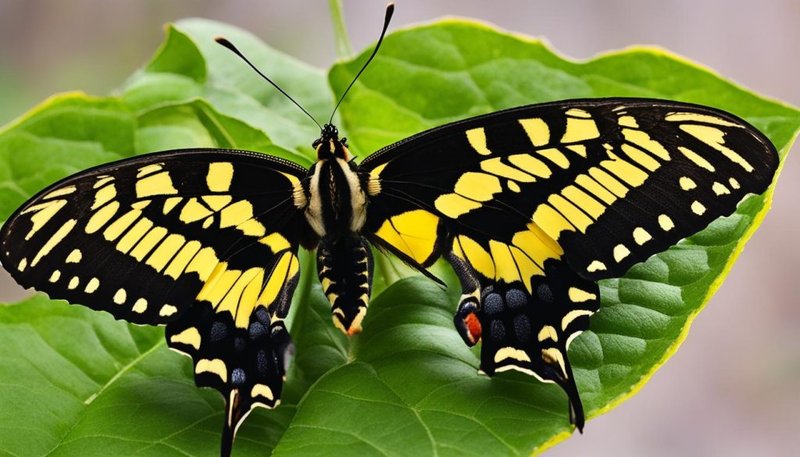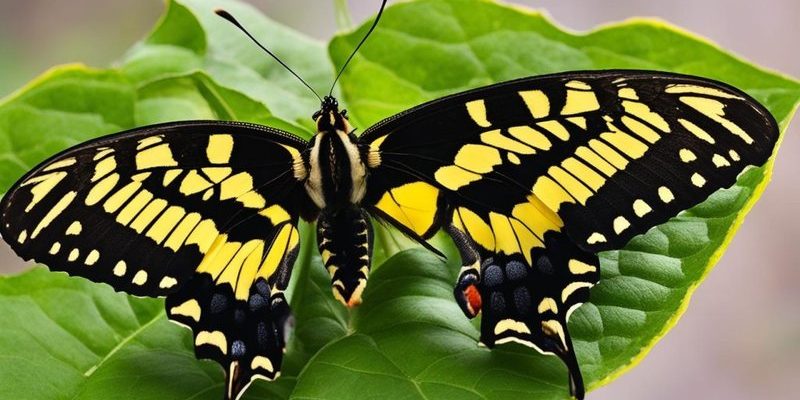
The swallowtail butterfly is a family of butterflies known as Papilionidae and has earned its name from the tail-like extensions on its wings. Just like a fine painting, each species boasts unique colors and patterns, making them instantly recognizable. But there’s so much more to them than just pretty wings. Understanding their evolution and history gives us a deeper appreciation for their role in our ecosystem—and the changes they’ve lived through over millions of years.
What Are Swallowtail Butterflies?
Swallowtail butterflies belong to a family called Papilionidae, which includes around 550 different species spread across the globe. These butterflies are noted for their vibrant colors—think bright yellows, deep blues, and striking blacks. One defining characteristic is their “tails,” which look like little extensions trailing off their hindwings. They can vary in size, with some species being as small as a finger and others as large as a hand.
You might be wondering why they have these tails. Well, they seem to confuse predators. Birds can mistake these tail extensions for the butterfly’s head, giving the butterfly a split-second advantage to escape. Essentially, it’s nature’s clever little trick against its enemies!
Origins and Early Evolution
The story of swallowtail butterflies really kicks off in the Late Jurassic period, about 150 million years ago. Fossil evidence, though scarce, indicates that butterflies as a whole began diversifying around this time. Most scientists agree that ancestors of the swallowtail group emerged in Asia and spread from there.
Over millions of years, swallowtails evolved alongside flowering plants. This relationship is a classic example of co-evolution—as plants developed new traits, butterflies adapted to take advantage of those changes. For instance, some species have specialized mouthparts that allow them to extract nectar from specific flowers, showcasing how deeply interconnected their evolution is with the plant world.
Characteristics That Set Swallowtails Apart
Swallowtail butterflies are easily recognizable due to their distinct traits. Here are some of their defining characteristics:
- Wing Shape: They have broad, often triangular wings adorned with colorful patterns.
- Tails: The tail-like projections are not just for show; they play a crucial role in their survival.
- Coloration: Their bright colors often serve as a warning to predators about their potential toxicity.
- Life Cycle: Like all butterflies, they undergo four life stages: egg, larva (caterpillar), pupa (chrysalis), and adult.
These characteristics not only add to their beauty but also provide clues about their survival strategies in the wild. From evading predators to attracting mates, every detail plays a part in their life story.
Diversity of Swallowtail Species
Within the swallowtail family, there’s a stunning diversity of species. For example, the Eastern tiger swallowtail, with its striking yellow and black stripes, can be found across North America. Meanwhile, the magnificent swallowtail from Australia is known for its breathtaking blue and black hue.
Let’s take a look at a few notable species:
- Swallowtail (Papilio machaon): This is one of the most widespread species, found in Europe, Asia, and North America.
- Pipevine Swallowtail (Battus philenor): Known for its iridescent blue wings, this species feeds on pipevine plants, which make it toxic to predators.
- Spicebush Swallowtail (Papilio troilus): This butterfly is often mistaken for a toxic species due to its mimicry, which effectively deters birds.
The wide variety in swallowtail butterflies illustrates their adaptability in different environments—from forests to fields to urban gardens.
Life Cycle of the Swallowtail Butterfly
Swallowtails undergo a fascinating life cycle that involves four distinct stages: egg, larva, pupa, and adult. Here’s a breakdown of each phase:
1. Egg: The female lays eggs on specific host plants. Each species has its preferred plant, which the caterpillars will eventually eat.
2. Larva (Caterpillar): Once hatched, the caterpillars eat voraciously. They’re often camouflaged to blend in with their surroundings. Some even mimic the appearance of twigs or bird droppings!
3. Pupa (Chrysalis): After growing sufficiently, the caterpillar forms a chrysalis where it undergoes metamorphosis. This stage can last from a few weeks to several months, depending on the species and environmental conditions.
4. Adult: Finally, the adult butterfly emerges. It will pump blood into its wings, allowing them to expand before taking its first flight.
Each phase is crucial for the butterfly’s survival and ensures that they can continue their species for generations to come.
Swallowtails and Their Role in the Ecosystem
Swallowtail butterflies play a vital role in ecosystems. As pollinators, they help plants reproduce by transferring pollen from one bloom to another. You might compare them to tiny gardeners of the natural world, ensuring that flowers bloom and seeds scatter.
In addition to pollination, they serve as an important food source for various predators, including birds and other insects. Their interactions within the food web illustrate the delicate balance of nature. If swallowtails were to decline, it could have a ripple effect, impacting plant reproduction and the animals that rely on those plants for food.
Conservation of Swallowtail Butterflies
Unfortunately, many swallowtail species face threats due to habitat loss, climate change, and pesticide use. Conservation efforts are essential to protect these beautiful insects and their habitats. Here’s how you can help:
- Plant Native Flowers: Creating a butterfly garden with native plants provides essential food for adult butterflies and caterpillars.
- Avoid Pesticides: These chemicals can harm butterflies and their habitats. Consider organic gardening practices instead.
- Participate in Citizen Science: Joining local butterfly counts or conservation programs can help track population numbers and strategies for protection.
Every small effort contributes to the larger goal of conserving swallowtails and their incredible diversity.
A Bright Future for Swallowtail Butterflies
Swallowtail butterflies have a rich evolutionary history and play an important role in our ecosystems. Their beautiful diversity and fascinating life cycle not only enchant us but also remind us of the interconnectedness of life. By understanding and appreciating these butterflies, we can contribute to their conservation and ensure their survival for future generations.
So next time you see a swallowtail fluttering by, take a moment to admire its beauty and the story it carries from millions of years of evolution. It’s a reminder of nature’s resilience and transformation, one breathtaking butterfly at a time.

